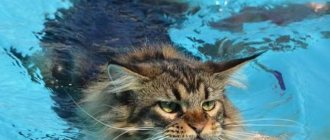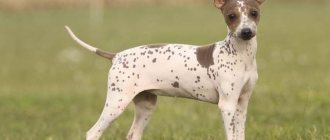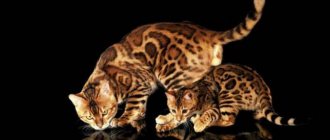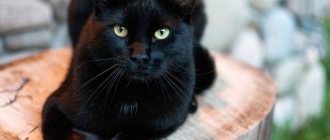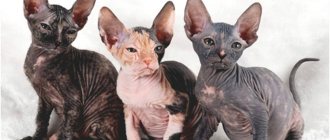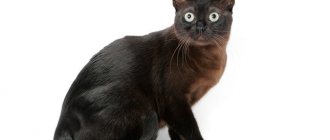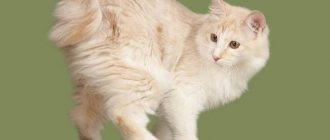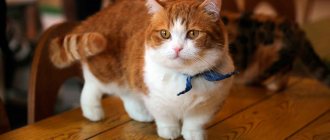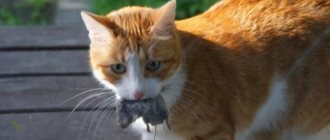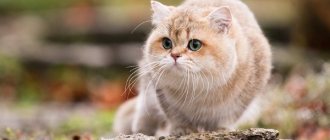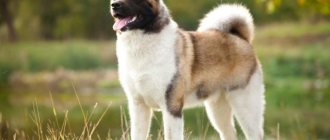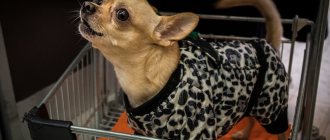Cats appeared long before the appearance of the first civilizations. And they have been living side by side with humans for thousands of years. Cats were first depicted by the ancient Egyptians around 1950 BC. What Egyptian cat breed has survived to this day?
Cats were important to the ancient Egyptians. They tamed them and took care of them more than themselves. Despite Egypt's huge role in the domestication of cats, there are not many breeds left that have their roots in this desert country. Let's take a closer look at six breeds that can be traced back to Egypt.
Egyptian Mau
By the name it is easy to understand where this cat breed came from. We can say that the Egyptian Mau is the most Egyptian of all modern cat breeds. These spotted animals bear a striking resemblance to those depicted in ancient Egypt. And this breed was worshiped many centuries ago.
The breed was almost exterminated during the Second World War. The Russian princess saved the Egyptian Mau breed. This is the only domestic cat that has been spotted naturally. They are the fastest of all domestic cats, reaching speeds of up to 50 km per hour.
The Ancient Egyptians and Their Devotion to Cats
The ancient Egyptians and their devotion to cats were, frankly, on a whole other level. The greatest example is the Battle of Pelusium (525 BC), when Cambyses II of Persia conquered Egypt. It was said that Cambyses knew of Egypt's love of cats, which he used to his advantage during the war. He asked his men to collect as many cats as possible and even paint pictures of cats on their battle shields.
As they moved towards the city of Pelusium, several cats walked ahead, and the rest were held in the arms of Persian soldiers. The Egyptians were so reluctant to engage in battle for fear of harming the cats that they surrendered to defeat and allowed the Persians to conquer the kingdom of Egypt.
Likewise, in ancient times, there were many laws protecting cats. For example, if a person killed a cat, even by accident, the punishment would be death. In addition, the trade and export of cats to other countries is prohibited. When cats die, they will be mummified and their owners will leave them food. Sometimes cats were even buried with their owners to show how much they loved their beloved pets.
Mummified ancient Egyptian cats
So now you know why the Egyptians loved their cats so much! The next time you see one on the street, you can treat it with more respect, just like ancient civilizations did thousands of years ago!
Shirazi - Egyptian cat breed
In Egypt, you can see many Shirazi cats roaming the streets. If you believe the myths and ancient legends, then this breed of cats was formed when Egypt was part of the Persian Empire. The breed is not registered, but in their homeland they are common.
Shirazi is a cross between the Egyptian Mau and the Persian. They have the same colors and markings as the Egyptian Mau. They are calmer than Mau. They combine the best features of both parent breeds.
Why were cats revered in Egypt?
Such deification showed the Egyptians’ admiration for the cat’s cleanliness and her care for her kittens. In addition, a mysterious nocturnal lifestyle, eyes glowing in the darkness and an incredible ability to instantly and silently disappear and appear, silently stepping with soft paws. All this caused surprise mixed with fear. Perhaps the cat has won respect for its freedom-loving character and independence. Although she lives next to a person, she at the same time walks on her own and enters another, otherworldly world.
Temple cats lived happily, eating the best food. Fish were bred in ponds especially for them, and assigned slaves guarded and looked after the tailed goddesses day and night. They were served by their own priests and worshiped by numerous admirers. Looking after a cat was considered an honorable and especially respected matter. The priests of Bast carefully watched every movement of the temple cat in order to interpret the signs that the goddess thus gave through her earthly incarnation.
Almost every family of ordinary Egyptians had a cat at home. She was looked after as if she were the most precious creature. If, God forbid, a fire started in the house, the cats were taken out of the fire first, before the children. If a cat died, then its funeral was held with great honor. Family members, mourning her loss, wore mourning clothes, sang funeral songs, and shaved their heads and eyebrows as a sign of mourning. Dead cats were wrapped in linen, anointed with fragrant oils and mummified using balm. Only then, according to beliefs, could the soul of the family pet be reborn in a new body after death. In order for the cat to feel good in the afterlife, toys that she loved during life, and even mummies of mice, were placed with her.
Abyssinian
Although it is not proven that Abyssinians originated in ancient Egypt, they are very similar to the African wild cat. Their closest ancestors originated in the Nile Valley, but the Abessinian breed was created in Great Britain. These cats were brought from Abyssinia - modern Ethiopia, after a military expedition.
During World War II, this cat breed almost disappeared. After World War II the breed was repopulated, and feline leukemia almost wiped them out again. Abessinians look like small pumas due to their ticked fur. Although Abyssinians are prone to a number of health problems, they can live for more than 15 years.
Features of care
Combing
The Abyssinian's coat is short, so it does not require special care.
Going through the fur with a furminator once a week is more than enough.
During molting, it is better to bathe cats more often to wash away dead hairs - pets respond favorably to the procedure.
Trim your nails before bathing. They can polish them on a scratching post - don’t forget to buy one.
To maintain physical fitness and direct your cat’s activity in the right direction, often play with your pet: balls, wind-up mice, a yo-yo, or just a bow on a string.
The ears of Abyssinian cats are large, so they should be cleaned regularly to avoid the development of infections.
Clean with a cotton pad or a damp cloth once every two weeks.
To make cats feel calm, allocate a place in the room for a house or bed. Don't forget about toys.
You can read about how to make a cat house with your own hands here:
Walk
Today Abyssinian cats are domestic cats. That's why they are not walked on the street. However, if you do take your pet out, put a flea and tick collar .
They have enough walking around the entire house, wherever the owner goes.
To maintain physical fitness and direct activity in the right direction, often play with your pet: balls, wind-up mice, a yo-yo, or just a bow on a string.
The Abyssinian cat constantly lacks attention. She will follow you everywhere: into the room and corridor, onto the balcony and into the kitchen. When meeting its owner, the cat will invariably say hello by purring affectionately
Nutrition
Abyssinians are real picky eaters, as befits royalty.
But if they like the dish, problems with collecting food can be avoided.
The Abyssinian cat's diet should be balanced, rich in vitamins, minerals and various microelements.
All this is contained in ready-made wet and dry food .
As for natural food, feed them three times a day. And don't forget about clean water.
Abyssinians are real picky eaters, as befits royalty.
- Like all predators, Abyssinians love meat. Give 100-140 g of meat per day: beef, veal, minced meat or chicken, chicken (but without bones), offal (if your pet likes them). Alternate meat products to diversify your diet.
- A couple of times a week, a raw or soft-boiled egg.
- Cereal porridges that do not cause bloating.
- Fermented milk products, milk.
- Vegetables, raw or cooked.
- Fruits. Some cats of this breed love melons and bananas.
- You should not give fatty pork, legumes, oatmeal, river fish, food from the table, and even seasoned with spices.
The Abyssinian's coat is short, so it does not require special care. Going through the fur with a metal fine-tooth comb once a week is more than enough.
Nile cat
There is some controversy surrounding the Nile cat. This is essentially a wild cat breed discovered in Egypt. Some consider them to be Egyptian Mau, although the International Cat Association has recognized them as a separate experimental breed. These are street cats that no one takes care of in Egypt.
An American rescue group is relocating these cats to America. This breed can be identified by the mantle on its back and sides, which is distinct from the rest of its body. These cats come in a variety of colors and patterns, with long and short hair.
How to choose a kitten
Back at the end of the 20th century, the breed was very rare; there were queues for kittens in nurseries. The wait for a kitten could take several years. Now the situation has improved a little. The development of the breed occurs simultaneously in many countries of America, Europe and Asia. There are also Egyptian Mau nurseries in Russia.
When choosing a kitten, be sure to study the documents, the purchase and sale agreement, your responsibilities as a buyer, the conditions for admission to breeding and other important points.
Due to the rarity of the breed, Egyptian Mau kittens are quite expensive. The cost of a kitten starts from 40 thousand rubles , the final price depends on the class of the pet and its compliance with the standard.
Nurseries
- LA DENTELLE – Murmansk.
- MYTIME – Arsenyev (Primorsky Territory) www.time-my.ru.
- EGYPTIAN POWER – village. Pravdinsky (Moscow region) www.egyptsila.ru.
Chausie
This breed was created by crossing the Nile cat with domestic breeds. Chausie cats have been found in several ancient Egyptian temples, indicating that the Egyptians valued them even before they were bred into the Chausie we know today.
This is one of the largest breeds of domestic cats, sometimes weighing up to 11 kg. This is one of the few cat breeds that love water. In 2013, the International Cat Association finally registered the breed.
Interesting facts about the breed
- Primary teeth often do not fall out until permanent teeth emerge, so a Mau may have two complete sets of teeth. This may result in sensitivity to touch around the mouth and usually occurs between four and seven months.
- The Mau's gestation period is longer than most other breeds. Kittens can be born any time between 63 and 67 days. Some females walk for 70 days and give birth to healthy kittens without difficulty.
- Mau love to “ruffle” household items. This could be any thing such as a house shoe, a sock, clothing, a cup on the table, etc. Suddenly the thing becomes an enemy that must be brutally defeated.
- Mau have a quiet musical voice, sometimes they walk around the house and make various sounds, sometimes chirping like a bird, sometimes giggling. This usually happens when the cat is in a good mood or sees something particularly exciting, such as an insect.
Savannah cat
Savannah cats are among the largest domestic cats. They can reach a weight of up to 11 kg. and are very similar to their wild cat ancestors. This breed was created by crossing a domestic cat with a wild African cat named Serval. There is no evidence that this breed originates directly from Egypt, but servals have a distinguished history in Egypt. In Ancient Egypt, servals were exotic gifts and were traded as far back as the time of Tutankhamun.
Early generations are the largest, and later generations are closer to the size of the average domestic cat. They have strong hunting instincts, so it is best not to keep them in homes with birds, fish or other small pets. Savannah cats are one of the few felines known to love water.
A soldier with the soul of an artist
It is known that the future Emperor Nicholas I was not prepared to rule the state - he was the youngest heir and, if not for the abdication of his brother Constantine in 1825, he would never have become a monarch. According to tradition, Nikolai Pavlovich received a military education, but there was a hobby in his life that, at first glance, had nothing to do with the army and navy.
Image of Nicholas I and Tsarevich Alexander Nikolaevich in the studio of the artist G. Villevalde - Source: hermitagemuseum.org
Since childhood, Nikolai loved to draw. First, he asked teachers to draw something on paper, and then he happily colored the drawing and gave it to someone close to him. At the age of seven, Nikolai Pavlovich began taking separate painting lessons, and his first teacher was the artist “on historical themes” I.A. Akimov, with whom the future ruler studied twice a week and made great progress.
Already in his mature years, Nicholas I will decide to master the art of engraving, and this time he will take lessons from O.A. Kiprensky (creator of the famous portrait of A.S. Pushkin). Having succeeded in this technique, Nikolai Pavlovich released a series of engravings “Uniforms of Russian troops”, carefully drawing out every detail of the military uniform: cuffs, collars, buttonholes. In addition, in 1829, the emperor created several watercolor works on the theme of the Italian Guard and pencil drawings depicting women in full cuirassier uniform.
Staff officer of the artillery team and sailor of the fin company of the Guards crew, 1844-1855. — Source: navyparade.mil.ru
One of Nicholas I’s favorite pastimes was creating sketches of uniforms for the Russian army with his own hands. The emperor's enthusiasm was so great that he could work on them day and night, refining and improving them. To do this, he even had to get acquainted with the basics of sewing and participate in the selection of fabrics and accessories for military uniforms. By the way, this hobby was also inherited by his son Alexander II, who made a significant contribution to changing the uniform of Russian soldiers and officers during the Great Reforms.
Description and appearance
The leopard-like posture and coloring make the Egyptians resemble their cave paintings.
Males are larger and weigh approximately 4.5-6 kg. Representatives of the breed do not exceed 3-4.5 kg.
Animals have a wedge-shaped head with rounded lines. Their muzzle is beautifully contoured and looks harmonious. It resembles a soft wedge that follows the contours of the head. The neck is short and beautifully curved.
The ears are large, standing high above the forehead. The eyes are slanted and widely spaced.
The body is long, graceful in shape, with strong muscles. The tail is of medium length. It is widened at its base and tapers to a dark-colored tip.
The hind limbs are long, while the forelimbs look shorter. But representatives of the breed do not lose their elegance because of this feature.
Their fur is smooth and adheres tightly to the skin. The color of the cat must comply with felinological rules and include the following types of tones:
- Bronze. Then the Mau's tan marks will be brown.
- Smoky. The gray representative of the breed in this case is decorated with a silver undertone and black markings.
- Marble. Such cats are rare and are similar in color to their ancient ancestors.
- Silver. Animals may have black spots.
Character and psychology
Egyptian Mau are real energizers. Playful, cheerful, suffering from tireless curiosity. In the mornings they do an excellent job as a gentle alarm clock, and in the evenings they brilliantly serve as an antidepressant.
Mau love is unobtrusive, but eternal. The cat will be devoted to its owner until its last breath. She chooses one family member as her favorite. Her entire cat's soul will belong to him.
When meeting strangers, the Egyptian woman will not show aggression, but at first she will be wary. Mau will be an excellent companion for heart-to-heart conversations.
But she won't meow. Prefers to communicate by purring. It will definitely surprise you with the widest range of purring sounds.
The hunter's instincts will not allow the spotted beauty to be indifferent to small rodents and birds. Therefore, leaving them alone is not recommended. But it will be an excellent neighbor for dogs and cats.
After a hearty lunch, the Mau is supposed to get a good night's sleep. At this time, you should not disturb her over trifles. Chronic lack of sleep makes the animal lethargic and stimulates the tendency to overeat.
Children are treated loyally, but require respectful treatment. They are ready to respond to the game, but will not tolerate insubordination. If the baby pulls the tail, the Mau will definitely hit back.
Health
Characteristic diseases
The health of Abyssinian cats is quite good due to their high mobility.
However, genetic abnormalities cannot be excluded: polycystic kidney disease (in blue varieties), atrophic retinopathy of the retina, problems with the blood, in particular, with the content of red blood cells.
Breeders who respect the breed conduct genetic tests and reject carriers of these diseases.
Monitor your cat's diet. Errors in diet can lead to gingivitis, so check your pet's teeth frequently.
In addition, the Abyssinian loves to eat well – hence the overeating and problems with bowel movements.
With proper upbringing and enough attention, the Abyssinian will give you all his love
Vaccinations
The first vaccinations for kittens are given at 9 and 11 months. Previously, vaccination is not indicated for kittens, as teeth change.
In the future, vaccination is carried out annually.
At least 13.5 weeks before vaccination, it is worth washing the cats with flea shampoo and giving them an anthelmintic.
And don’t forget to mark it in your veterinary passport.
How did ancient Egyptian cats live?
The attitude towards cats was special. Science indicates that the cat was a sacred animal of ancient Egypt. They tried to provide comfortable conditions for them. They were carefully looked after and fed the best food. If they fell ill, their owners went to special pagan priests in the Bastet buildings and gave a certain amount of food. The cats living in these buildings had their own special servants who fed them, played musical instruments and took care of them in other ways.
If cats died, they were given a special funeral. They were mummified, and the coffin was made as expensive as possible using gold, carvings, and precious stones. The family whose pet died observed mourning and ate little in the days immediately after the pet’s death. If someone killed a cat, it was severely punished with a very large fine or even the death penalty. In these cases, much depended on the social and property status of the owner.
